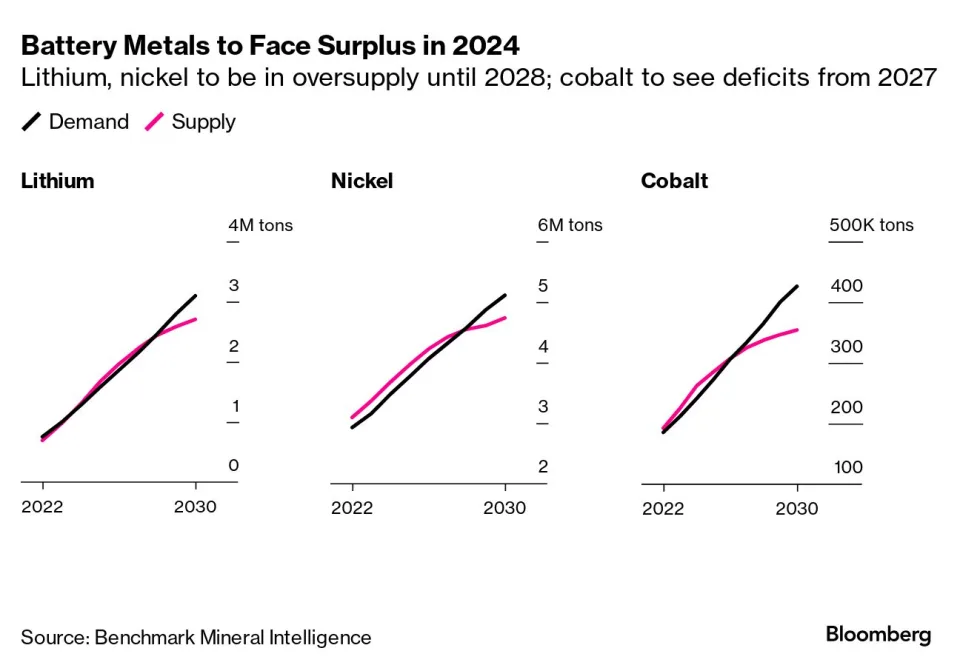
In the fast-moving world of battery metals, 2022 already feels like a bygone era. Back then, prices were soaring, automakers were fretting about long-term shortages and Elon Musk was describing lithium costs as “insane.”
A year-and-half on from the Tesla Inc. CEO’s comments, the market dynamics for metals crucial to the energy transition have flipped. Lithium has tumbled almost 70% so far this year, while nickel has plummeted around 40%. Cobalt too has dropped.
This trio of electric vehicle battery ingredients is now among the worst-performing in the commodity universe — laid low by slowing sales growth for electric vehicles as well as supply increases coming out of China, Indonesia and the Democratic Republic of the Congo. The turnaround in fortunes is a reminder that the path to cleaner fuels is unlikely to be a smooth one.
“There’s certainly enough supply of all at present,” said Colin Hamilton, managing director for commodities research at BMO Capital Markets Ltd. Prices for the battery metals “were too high to be sustainable” once output expanded more quickly than expected, he said.
EV sales are still rising, but higher interest rates and uncertain economic conditions in major economies are damping consumer demand. In China, the biggest market, there’s been a slowdown in year-on-year growth.
A “huge build-out” in Chinese battery capacity, aided by government policies, means supply outweighs demand by two to one, ANZ Group Holdings Ltd. analysts Daniel Hynes and Soni Kumari said in a note last week. This has seen battery markers cut output and reduce their inventories, they said, adding that lithium, nickel and cobalt prices are likely to remain depressed in the short term.
The lower metal prices are providing some cost relief to automakers and battery producers and could lead to cheaper EVs for consumers. BYD Co., China’s biggest EV manufacturer, and Contemporary Amperex Technology Co., the country’s top battery producer, have both benefited from lower lithium costs this year.
On the metal supply and processing front, several developments have weighed on prices. There’s been a sudden expansion of low-grade lithium mining in China, while the nickel market has been transformed by a tsunami of low-cost production from Chinese-funded plants in Indonesia. There’s also more cobalt being produced, mainly from copper mines in the Democratic Republic of Congo and nickel projects in Indonesia, where it’s churned out as a by-product.
There will be an oversupply of the three battery metals for the next few years, according to forecasts from industry consultancy Benchmark Mineral Intelligence. The nickel and lithium markets won’t be in deficit until 2027 and 2028, respectively, while demand will outrun supply for cobalt from 2026, it said.
“Lithium prices will continue to face downward pressure in 2024 and 2025 as the release of new supply sources outpaces demand,” Li Jiahui, an analyst at trading company Xiamen Xiangyu New Energy Co., said at a conference late last month.
Threat to Mining
There are still upside risks for battery metals, however. The probability is rising that Indonesia, which produces more than half the world’s nickel, could take policy steps to boost prices, Citigroup Inc. said in a note last month. China, meanwhile, is planning to boost its strategic stockpiles of cobalt, which is also important in the defense and aerospace industries.
In the longer term, the question is whether the current cycle of lower prices sees companies canceling or delaying plans for new mines or refineries for the coming decade — absent policy support from governments aiming to build out their own supply chains.
Albemarle Corp., the world’s largest lithium producer, says this is already starting to happen. Prices are now at levels that are threatening a great number of higher-cost projects, executives said on a conference call on Thursday.
Speaking in London last month, Sue Shaw, head of energy transition and battery raw materials at Wood Mackenzie, said the turbulence was not yet over — even if markets are coming of age.
“Prices for battery raw materials will remain volatile, but future cycles are becoming more sustained as markets are showing signs of maturing,” she said. “The pressure to deliver is huge, even with recycling.”
